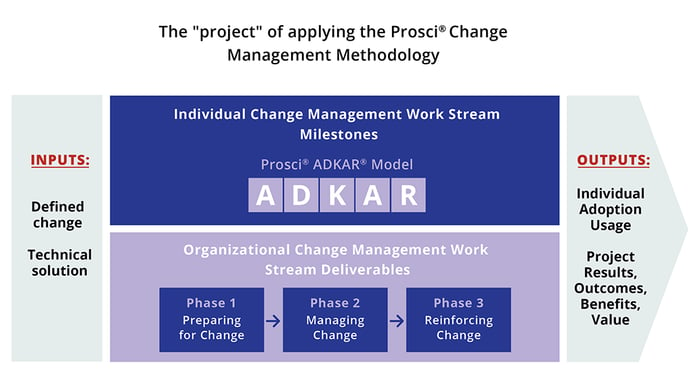Change Management in Project Management Speak

3 Mins
Updated: August 27, 2025
Published: June 27, 2017

In brief: you can build greater buy-in and understanding of change management with project managers and project teams if you speak their language.
Nelson Mandela once said, "If you talk to a man in a language he understands, that goes to his head. If you talk to him in his language, that goes to his heart." While the value of change management is increasingly recognized in organizations today, many practitioners still struggle to get a seat at the project table. Expressing change management not in a language that project managers understand, but in their language can help. By translating the work of change management into the framework and language of project management, you can better express what you do and the value you bring.
Change Management Glossary (In Project Management Speak)
Intent
Project Management Definition:
Determined and purposeful state of mind accompanying an act.
(Source: www.businessdictionary.com)
Change Management Definition:
To drive and capture the portion of project benefits that depends on adoption and usage (read more about change management ROI).
Objective
Project Management Definition:
Something toward which work is to be directed, a strategic position to be attained, or a purpose to be achieved, a result to be obtained, a product to be produced, or a service to be performed.
(PMI® PMBOK® Guide)
Change Management Definition:
Change management will:
- Improve employee adoption and usage of the solution to drive project results and outcomes
- Create a customized and scaled approach that aligns with the project lifecycle and milestones
- Create deliverables (strategy and five plans) that support the key milestones of an individual's successful transition
Scope
Project Management Definition:
The work that must be performed to deliver a product, service, or result with the specified features and functions.
(PMI® PMBOK® Guide)
Change Management Definition:
In the scope of change management:
- Identify and define the individual changes required by the project
- Create a change management strategy
- Develop customized, scaled, targeted and best-practices-based plans (communications, sponsor, coaching, training, resistance management)
- Create adoption and usage metrics
Out of scope:
- Define the change at hand
- Create the technical solution
Work Streams
Project Management Definition:
The progressive completion of tasks completed by different groups within a company which are required to finish a single project.
(www.businessdictionary.com)
Change Management Definition:
Change management has two work streams:
- Individual Change Management Work Stream: Milestones needed for a single person to make a change successfully. Answering the question: how does a single person make a change successfully?
- Organizational Change Management Work Stream: Deliverables (strategy and plans) that support individual transitions. Answering the question: what can the team do to support the individual transitions?
Milestones
Project Management Definition:
Scheduled event that indicates the completion of a major deliverable event (or a set thereof) of a project. Milestones are measurable and observable and serve as progress markers (flags).
(www.businessdictionary.com)
Change Management Definition:
The milestones of change management are the building blocks of successful change for each impacted employee who must change how they do their jobs. The Prosci ADKAR Model defines the five building blocks - or milestones - of a successful individual transition as:
- Awareness of the need for change
- Desire to participate and support the change
- Knowledge on how to change
- Ability to implement the required sills and behaviors
- Reinforcement to sustain the change
Deliverables
Project Management Definition:
Any unique and verifiable product, result, or capability to perform a service that must be produced to complete a process, phase, or project.
(PMI® PMBOK® Guide)
Change Management Definition:
The deliverables of change management are created by applying a structured approach. The deliverables support the achievement of the individual milestones listed above. The Prosci 3-Phase Process includes the following deliverables:
Phase 1 - Preparing for Change
- Assessments and risk profile
- Change management strategy
- Supporting structures (team and sponsor model)
Phase 2 - Managing Change
- Communications plan
- Sponsor roadmap
- Coaching plan
- Training plan
- Resistance management plan
Phase 3 - Reinforcing Change
- Feedback plan
- Compliance audit plan
- Recognitions and rewards
Input
Project Management Definition:
Any item, whether internal or external to the project that is required by a process before that process proceeds.
(PMI® PMBOK® Guide)
Change Management Definition:
The input to the change management process is: a defined change in the organization that will impact how individuals do their jobs. The input can be a small, incremental change or a large, radical change. Example changes that can be the input to the change management process include:
- New IT hardware or software system
- Business process optimization
- Customer Relationship Management system
- Electronic Health Records
- Virtual or telework
- New payroll system
- Reorganization
- Enterprise Resource Planning deployment
- New product launch or market expansion
Output
Project Management Definition:
A product, result, or service generated by a process. May be an input to a successor process.
(PMI® PMBOK® Guide)
Change Management Definition:
There are two main outputs of applying change management. At the individual level, the output is successful transitions (through the ADKAR Model), which result in higher levels of adoption and usage of the solution by employees. At the project level, the output is greater benefit realization, results and outcomes delivery, Return on Investment and overall success.

Conclusion
Context and language are critical in building support for change management with project leaders, project managers and project teams. This tutorial provided direction and insight on how to use context and language to engage project teams. "Context" is addressed by focusing on project benefits and the contribution of adoption and usage to those benefits. "Language" is addressed by positioning and framing change management in terms of intent, objectives, scope, work streams, milestones, deliverables, inputs and outputs.



